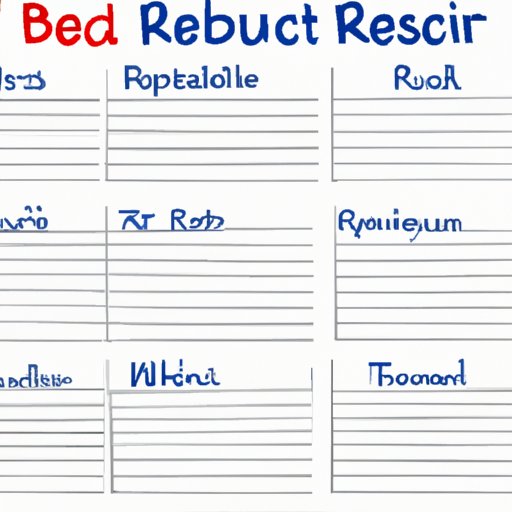Introduction
Rubric writing is an important tool for assessing student performance and providing feedback. A rubric is a set of criteria used to evaluate student work, such as essays, presentations, projects, and other assignments. Rubrics can be used to grade student work, provide feedback to students, and track student progress over time. In this article, we’ll explore what rubric writing is, how it works, and the benefits of using rubrics to assess student work.
Section 1: An Overview of Rubric Writing: What It Is and How It Works
A rubric is a document that outlines the criteria for evaluating a particular type of assignment. It typically includes a list of criteria and descriptors for each criterion. For example, if you are grading an essay, your rubric might include criteria such as “Organization”, “Grammar and Mechanics”, and “Content and Development”. Each criterion will have a list of descriptors that indicate different levels of performance for that criterion. For example, for the “Organization” criterion, you might have descriptors such as “Excellent”, “Good”, “Average”, and “Needs Improvement”.
Rubrics are often used to grade student work, but they can also be used to provide feedback to students and track student progress. By clearly outlining the criteria for success, rubrics can help students understand what is expected of them and motivate them to do their best work. Rubrics can also help teachers provide more meaningful feedback to students by focusing on specific criteria rather than giving a general impression of the quality of the work. Finally, rubrics can be used to track student progress over time, which can help teachers identify areas where students need additional support or guidance.

Section 2: Breaking Down the Elements of Rubric Writing
When creating a rubric, there are several key elements to consider. First, it’s important to identify the criteria for assessing the student work. These should be clear and concise, and should reflect the goals of the assignment. Second, it’s important to create descriptors for each criterion that are easy to understand and accurately reflect the level of performance. Third, it’s important to create a scoring system that allows for consistent evaluation of student work. Finally, it’s important to create a rubric that is easy to read and understand.
When designing a rubric, it’s important to keep it simple and straightforward. The criteria should be clearly stated and the descriptors should be easy to understand. It’s also helpful to provide examples of what each descriptor looks like in practice. This can help students better understand the expectations for the assignment. Additionally, it’s important to provide a scoring system that is easy to follow and consistent across all the criteria.

Section 3: Crafting Effective Rubrics for Assessing Student Work
Once you’ve identified the criteria for assessing student work, it’s time to craft an effective rubric. When designing a rubric, it’s important to make sure it is clear and concise. The criteria should be clearly stated and the descriptors should be easy to understand. It’s also helpful to provide examples of what each descriptor looks like in practice. This can help students better understand the expectations for the assignment. Additionally, it’s important to provide a scoring system that is easy to follow and consistent across all the criteria.
It’s also important to consider the format of the rubric. For example, some rubrics use a numerical scoring system while others use a letter grade system. Additionally, some rubrics use a point-based system while others use a pass/fail system. Ultimately, the format of the rubric should be determined based on the objectives of the assignment and the learning goals of the students.

Section 4: Using Rubrics to Track Student Progress
In addition to using rubrics to grade student work, they can also be used to monitor student progress over time. By tracking student performance on each criterion, it’s possible to identify areas where students are struggling and areas where they are excelling. This information can then be used to provide targeted feedback to students and set goals for future learning.
It’s also important to consider the format of the rubric when using it to track student progress. Some rubrics use a numerical scoring system while others use a letter grade system. Additionally, some rubrics use a point-based system while others use a pass/fail system. Ultimately, the format of the rubric should be determined based on the objectives of the assignment and the learning goals of the students.
Section 5: Benefits of Rubric Writing for Teachers and Students
Rubric writing has many benefits for both teachers and students. For teachers, rubrics can help streamline the grading process and provide more meaningful feedback to students. They can also help teachers track student progress over time and identify areas where students need additional support or guidance. For students, rubrics can help them understand the expectations for an assignment and motivate them to do their best work. They can also provide students with a clear roadmap for success and help foster collaboration between teachers and students.
Conclusion
Rubric writing is an effective way to assess student performance and provide feedback. By clearly outlining the criteria for success, rubrics can help students understand what is expected of them and motivate them to do their best work. They can also help teachers streamline the grading process, provide more meaningful feedback, and track student progress over time. We encourage you to experiment with different types of rubrics to find the best ones for your students.
(Note: Is this article not meeting your expectations? Do you have knowledge or insights to share? Unlock new opportunities and expand your reach by joining our authors team. Click Registration to join us and share your expertise with our readers.)
